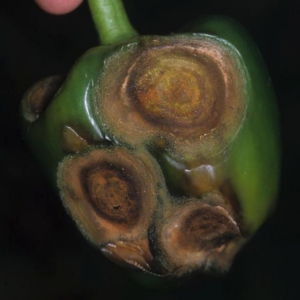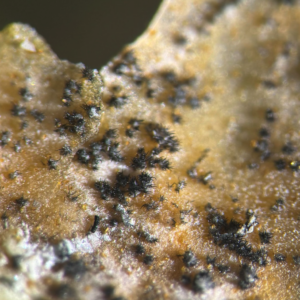Be on the Lookout for Pepper Anthracnose Caused by Colletotrichum Scovillei
go.ncsu.edu/readext?1077443
en Español / em Português
El inglés es el idioma de control de esta página. En la medida en que haya algún conflicto entre la traducción al inglés y la traducción, el inglés prevalece.
Al hacer clic en el enlace de traducción se activa un servicio de traducción gratuito para convertir la página al español. Al igual que con cualquier traducción por Internet, la conversión no es sensible al contexto y puede que no traduzca el texto en su significado original. NC State Extension no garantiza la exactitud del texto traducido. Por favor, tenga en cuenta que algunas aplicaciones y/o servicios pueden no funcionar como se espera cuando se traducen.
Português
Inglês é o idioma de controle desta página. Na medida que haja algum conflito entre o texto original em Inglês e a tradução, o Inglês prevalece.
Ao clicar no link de tradução, um serviço gratuito de tradução será ativado para converter a página para o Português. Como em qualquer tradução pela internet, a conversão não é sensivel ao contexto e pode não ocorrer a tradução para o significado orginal. O serviço de Extensão da Carolina do Norte (NC State Extension) não garante a exatidão do texto traduzido. Por favor, observe que algumas funções ou serviços podem não funcionar como esperado após a tradução.
English
English is the controlling language of this page. To the extent there is any conflict between the English text and the translation, English controls.
Clicking on the translation link activates a free translation service to convert the page to Spanish. As with any Internet translation, the conversion is not context-sensitive and may not translate the text to its original meaning. NC State Extension does not guarantee the accuracy of the translated text. Please note that some applications and/or services may not function as expected when translated.
Collapse ▲Written by Lina Quesada-Ocampo, Sarah Cochran-Murray, and Inga Meadows
Reports of pepper anthracnose outbreaks caused by Colletotrichum scovillei are increasing across the southeastern U.S., including nearby regions in South Carolina. As this emerging pathogen becomes more prevalent, North Carolina pepper growers should stay alert, particularly during transplant establishment and early fruit development. This disease poses a significant risk to both bell and specialty pepper production when weather conditions favor disease development; however, bell peppers seem to be more susceptible.
Colletotrichum scovillei is a recently distinguished species within the Colletotrichum acutatum complex and is notable for its ability to infect immature fruit, a characteristic that can lead to early yield losses. Typical symptoms include circular, sunken lesions that may produce pink to orange spore masses in the center under humid conditions (Figure 1). Spiked black spore masses called acervuli can also be seen in the center of lesions (Figure 2). These lesions can develop quickly and render fruit unmarketable.

Figure 1. Symptomatic concentric lesions on pepper fruits caused by Colletotrichum species. (Photo credit: Bugwood Wiki, photo by Gerald Holmes)

Figure 2. Acervuli with setae growing on the pepper leaf tissue from the anthracnose fungus (Photo credit: Sarah Cochran-Murray, NC State).
This pathogen is most commonly introduced into production systems through infected transplants or contaminated trays. Other species of Colletotrichum can be spread by seed, and although this has not been confirmed with C. scovillei, it is possible that contaminated seed may be a source of inoculum. The greatest risk of spread occurs in the field via splashing water, especially from rain or overhead irrigation, and through tools or worker contact.
To minimize the risk of introduction, growers and transplant producers should inspect pepper transplants carefully before planting. Any transplants showing water-soaked lesions or soft stem decay should be discarded immediately. Trays and greenhouse tools should be disinfected between uses, and overhead irrigation should be avoided when possible to limit splash dispersal.
In the field, C. scovillei thrives in warm, humid environments. Frequent rain events, dense canopies, and poor air circulation can accelerate disease development and spread. Preventive management strategies include using drip irrigation, implementing crop rotation with non-solanaceous species for at least two years, and maintaining regular field scouting, especially during periods of wet weather.
Several fungicides can help protect developing fruit, but applications must begin before symptoms appear and must be rotated to avoid fungicide resistance.
For confirmation of suspected anthracnose infections, growers can submit samples to the NC State Plant Disease and Insect Clinic. Early identification is critical to preventing widespread losses, especially given the aggressiveness of this pathogen on young fruit.
For assistance with diagnosis, rotation planning, or fungicide scheduling, contact your local Extension agent.
Taking action now to prevent introduction and early infections can help protect pepper crops from this damaging disease throughout the season.
For real-time updates and other disease alerts, follow our team.


